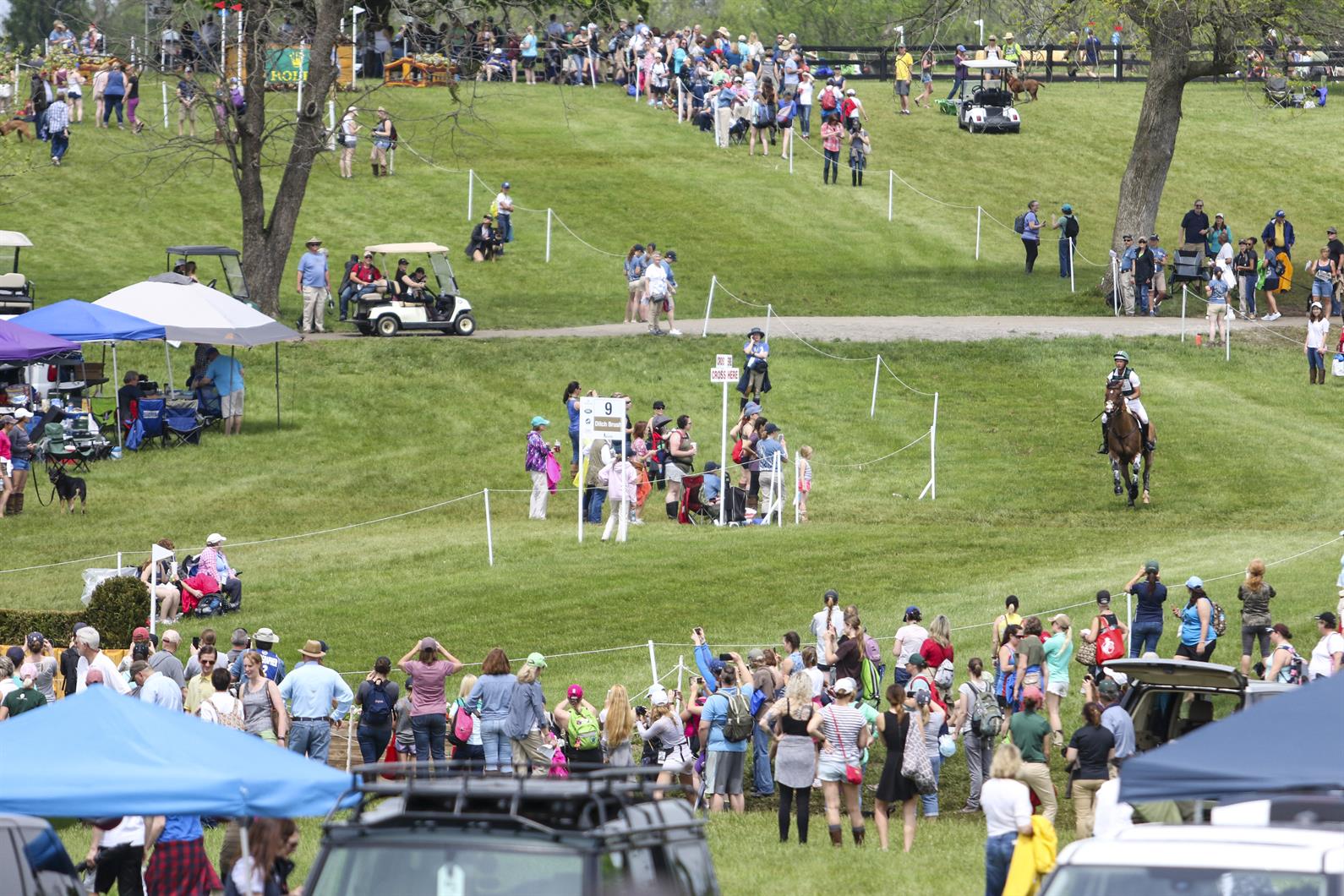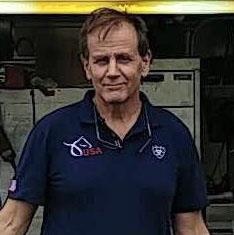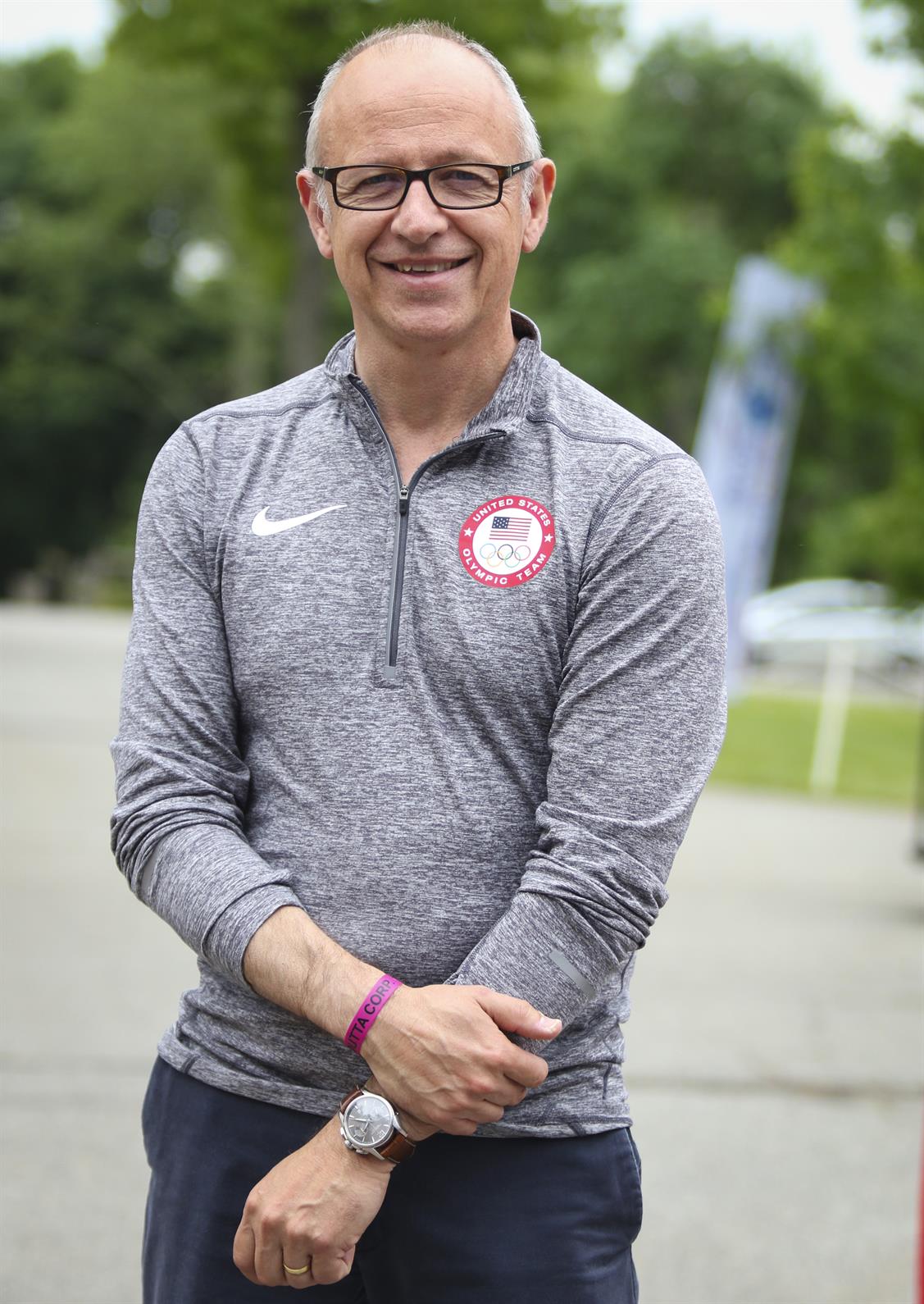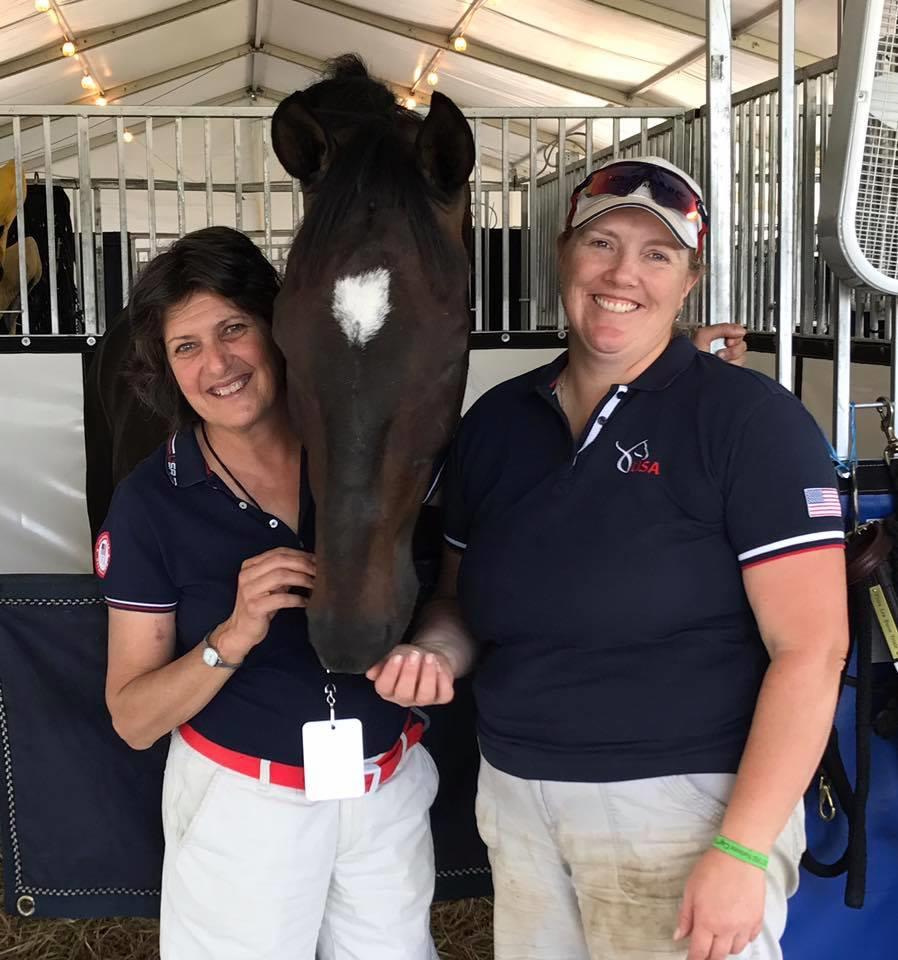In Their Own Words: Behind the Scenes with U.S. Team Staff
U.S. team staff are busy behind the scenes at LRK3DE and many other events throughout the year, supporting U.S. efforts to identify, select, develop, and field the strongest Land Rover U.S. Eventing Team possible.

High-performance eventing isn’t only about the horses and riders. While the human and equine athletes are often the most visible components of any U.S. equestrian team, they’re backed up by a comprehensive and vital support system behind the scenes. That staff includes such experts as human performance biomechanics expert Andy Thomas, who works with human athletes, and equine physiotherapist Jo-Ann Wilson; veterinarian Dr. Susan Johns; and farrier Steve Teichman.
We caught up with several of these crucial resources to ask their thoughts about their contributions to developing and maximizing the performance of the Land Rover U.S. Eventing Team, and what they do at individual competitions like the Land Rover Kentucky Three-Day Event presented by Mars Equestrian.
Dr. Susan Johns
Land Rover U.S. Eventing Team Associate Veterinarian
The Plains, Va.
“Each of the high-performance riders’ horses has their own private treating veterinarians and support staff that oversee their care on a routine basis. Throughout the competition year, I evaluate the listed horses along with a veterinary panel comprised of Dr. Duncan Peters and Dr. Brendan Furlong. In addition, our team farrier (Steve Teichman) and equine physiotherapist (Jo-Ann Wilson) routinely examine the horses. Together we provide connected, integrative medicine to meet the ever-expanding demands of our performance athletes. Our team-based approach helps to optimize performance, prevent injury, and aid in recovery.

Photo: Taylor Pence/US Equestrian
“Our equine athletes face many challenges during their rigorous competition schedules, and our goal is to provide them the care they need to remain competitive at the highest level. We work together to proactively monitor these horses to keep them in the game with lasting success.
“Our practice [Virginia Equine Imaging] serves as the official treating veterinarians at the Land Rover Kentucky Three-Day Event presented by Mars Equestrian. I will be assisting the veterinary delegates during in-barns, the arrival examinations of the horses prior to entering the Fédération Equestre Internationale compound. The veterinary delegates and support staff obtain the temperature, pulse, and respiration rates of each of the equine athletes to make sure they are healthy when they enter the FEI stabling. In addition, they evaluate their passports for identification and to make sure their vaccination requirements are in compliance.
"I will be on call throughout the event. I will be stationed at the dressage and stadium arenas during the competition and will receive any emergencies in the barn during the cross-country phase, as well as supporting our regular clients participating in the event. As the Land Rover U.S. Eventing Team associate veterinarian, I will be collaborating daily with the support staffs behind our high-performance eventers to ensure their safety and well-being throughout the competition.
“I am constantly rewarded by being surrounded by these tremendous equine athletes in the barns at their events. I love the ongoing collaborations with the support staffs behind these partnerships, including the farriers, veterinarians, grooms, owners, physiotherapists, coaches, and athletes. It takes a strong support team to maintain these athletes and help their performance peak at critical times throughout their careers.”
Steve Teichman
Land Rover U.S. Eventing Team Farrier
Unionville, Pa.
“I’m a problem-solver. That’s my job. I watch how people warm their horses up, whether they put them in ice, do they have to exercise them before they do a trot-up, I’m paying attention to what’s going on in the background. A lot of it is that observation.

Photo: Courtesy of Steve Teichman
“At Kentucky, if the weather changes, you might be swapping out shoes, cutting out pads, doing heel augmentation, which helps keep horses from grabbing shoes in the mud. There will be a lot of that sort of thing. I’m not a big tinkerer. I like to see these horses get through the first trot-up, and I don’t worry about anything until about 3 p.m. Friday when dressage is wrapping up.
“Then, all of sudden, riders start switching to think about Saturday’s cross-country and Sunday’s show jumping. Some of the horses might need a therapeutic shoe like a bar shoe or a heart-bar shoe, and that’s perfectly fine through dressage. But on cross-country day, you want less weight on the bottom of the foot, so we’ll switch them to an open shoe for their 10-minute run cross-country. If the footing changes because of bad weather, we’ll also make adjustments to the shoeing.
“There’s a pyramid of support people, from physiotherapists to veterinarians to grooms—there are so many people who help out to get these horses to a competition. It’s a huge deal.
“I don’t think the general public always knows how much everybody always works. Although Kentucky is not a team event, I’m there in the vet box. We’re helping take out studs. Or if someone is short-handed and can’t cool off a horse, you help cool off a horse. And, like they say, a craftsman’s eyes work twice as hard as his hands—at this point in the game, I’m watching everything. I want to see how these horses finish on cross-country. I want to see how the course goes. I want to see any little thing about a horse that I want to make a note of.
“I want to know the riders’ routines: do they get on their horses and walk them before the jog? Some do better in ice and some don’t. You want to know all the details. That’s a lot of my job at any event.
“You’re looking down the road. Everything with the Land Rover U.S. Eventing Team is on a four-year cycle, so we have the Pan American Games in Lima, Peru, this year, and that’s a big deal—but we’re also looking even farther ahead to the 2020 Olympic Games in Tokyo and making sure we can get a strong team there. So you have to have good success here in Kentucky and at Jersey Fresh, Bromont, and Great Meadows—wherever these horses and riders go. You’re trying to keep everybody together and on the same page. That way, when we have a list or horses narrowed down to four or five, I know exactly how to pack my trunks. I know what size shoes they’re wearing.
“So much of what you bring to the table as a farrier is knowing these horses for years. I know how they’ve finished at every event, and I’ve seen them every month, and even between times, you’re keeping in touch with your team coach. So it’s pretty intensive, and it’s definitely a group effort. And it’s great fun.”
Andy Thomas
USEF Performance Biomechanics Analyst of the Human Equestrian Athlete
Melton Mowbray, Leicestershire, England
“I’m the lead practitioner for human performance, so I look at the performance of the rider on the horse. We look at the rider biomechanics, and we look at symmetries, particularly. We look at how the rider sits and how the rider moves on the left rein and on the right rein, and then we assess the rider for symmetry by testing their muscle control and range of movement through their joints and their stability through one rein compared to the other. We look at how they make the horse move equally on one rein and the other. Riding is all about symmetry; you’re expected to sit on the horse and do the same thing on the left rein as you do the right rein, be it in dressage or be it in jumping. Most riders struggle with one side compared to the other. We try to neutralize that as much as possible to make them equal on both reins so that they lessen their problems and gain more marks in the dressage and are less likely to have problems with jumping.

Photo: Taylor Pence/US Equestrian
“Simple movements we analyze regularly are the half-pass to left and right in dressage, and we analyze circles left and right, or pirouettes in pure dressage, as well as [flying] changes left and right to see where they commonly make mistakes. With the pure dressage, we analyze every movement they do on every horse over a period of a year. We can break down every movement they do to left and right and see where they’re dropping marks. If it’s consistent on different horses, it’s probably the rider, not the horse.
“Along with the coaches, we look to see where the riders make mistakes, and if they commonly make more mistakes going one way than they do on the other, then often it’s the physicality of the rider, and not necessarily the horse. We’re looking at detail and where they can gain marks. We analyze each score, each dressage test, every movement, and equalize things as much as possible. With cross-country, we’d analyze when they run out, for example. Do they run out the same way every time? Some riders, if they have a run-out, they will always go out the same way. So we’d look at mistakes they make on a regular basis that affects that.
“Jumping is a little bit more complicated, because there are a few more factors involved, but, again, we look at whether they knock a few more poles on the right rein or the left rein.
“It’s not criticism; it’s positive feedback in terms of where they can improve their course and lessen the penalties, and the American riders are very open to it. The U.S. team riders I’ve worked with are really enthusiastic and are so keen to improve in every way they can. They’re very open to new ideas. We do a lot of work with them in training, then put it into practice for the actual competition.
“I’ve worked with some of these individuals over a number of years, and there are a handful of riders that have worked with me regularly. At the Land Rover Kentucky Three-Day Event, I’ll be based in the stable with the riders, so I’ll have a stall that I’ll use. That’s where I’ll be based. A lot of the riders will come see me before their dressage test to have their backs released, or we’ll either release tight tissue or wake muscles up that are inactive. We find riders have an inactive side and an overactive side; the idea is to equalize that by making one side more active and the other side less active so they don’t get tight or weak in one area.
“I’ll watch them ride and look at different things when they’re warming up or just training before a test, and then we’ll work on them for 10 or 15 minutes. Some riders will see me literally just before they get on. A lot of the other riders, all the team riders I’ve worked with, will do that.
“We do a lot of work even before the competition starts, and then we’ll work on them continually throughout the week. If they have two or three horses, I’ll work on them between horses. Often the riders are stiff and sore after cross-country on the morning of the jumping competition, so I’ll work on them again.
“My job is very much about making the rider more symmetrical with the horse. Then you have a horse that moves better and a happier, more balanced horse. When you see the horse after the spectacle of cross-country and it trots up the next morning, it’s just wonderful. For me, it’s about getting the rider and the horse safely through to the end of the three-day. The reward is really riders enjoying the horse, and, hopefully, by the end of it they’ve improved, whether they win or they don’t. It’s all about the improvement, whether their horse is better than it was prior to the event.
“The feedback from the riders is a reward, too, when they say, ‘That feels so much different once you’ve worked on me.’ But you see it in the horse more than anything. At the end of the day, it’s the rider who influences the horse, and the horse moves better and is more submissive and more adaptable to what the rider is requiring.
“The three-day is about a team effort: the grooms, the coaches, the rider, and then the vets and the farriers and everybody working on the horses in between. That’s the exciting thing: the hard work that goes into it.”
Jo-Ann Wilson
Land Rover U.S. Eventing Team Equine Physiotherapist
Camden, Maine
“There are a lot of behind-the-scenes people like me, the team vet, and the team farrier who work really hard with the riders and the horses to make sure that they’re at their personal best. My services are pretty important to the horse, because, like a human triathlon, eventing involves three separate disciplines. It’s a very rigorous sport, and there’s little recovery period between the three disciplines of dressage, cross-country, and show jumping, just as in a triathlon.

Photo: Courtesy of Jo-Ann Wilson
“My job is to make sure the horses are muscularly loose and able to maintain flexibility, range of motion, and ease of motion for all three phases. A fraction of an inch can make a difference in a competition, and it can make a difference between winning the gold and being an also-ran. Usually, I can get horses so mechanically efficient and increase their range of motion and ease of motion that they can get that inch. Then it is up to the riders to meet the challenges of the competition.
“I watch horses move and use muscular kinetics, as a gait analysis, and watch a horse walk to identify any restrictions in motion. I get the best view of muscle function at the walk. For example, is the right shoulder movement labored and harder to bring forward? Is the horse drifting to the left with his body? When he walks in a straight line, is he straight or is he throwing his haunches right or short in the left hind—I look for things like that. Then I talk to the rider, and they might say to me, ‘He’s harder shoulder-in right’ or ‘He’s not coming through as well as I want him to from behind’ or ‘He’s knocking a rail in front’ or ‘He’s leaning in my right rein really heavily.’ All of those restrictions of motion are going to be reflected in performance, and thus reflected in scores.
“Then I put my hands on a horse. After I’ve taken in this information, visually and from listening to the rider, I can feel where the tightness is. Muscles must be loose in order to give you the ease of motion and the range of motion. I use biomechanics. I use anatomy and physiology in my work, and I facilitate the physiological system to create the change. I use my hands and my eyes to figure out where the muscular resistance is occurring in the horse that is inhibiting free motion. If a horse is having trouble performing shoulder-in to the right, I’ll more than likely look to the lower back muscle on the left, which needs to release in order to give the shoulder-in right. So I go to very specific places where the muscles attach and release them in order to give the horse the free motion necessary for the movement being asked of him.
“I was the partner and associate of Jack Meagher, who founded sports massage in the 1950s. He worked with Jack LeGoff and the eventing team as the eventing team sports therapist. It’s not just massage as you might think it is, because Jack Meagher’s work was so anatomically accurate and combined anatomy with physiology and understanding a physiological system that releases the muscles. … I have to understand biomechanics and I have to be able to feel and to know exactly where a particular muscle inserts with a tendon into a particular bone in order to restore range of motion and freedom of motion. To do that I use three different techniques, all founded by Jack Meagher.
“After I work on a horse, I’ll ask the rider to take the horse out and just trot him or canter him in a long and low connected frame, just so the horse can experience the increase and change in range of motion. You can’t tell the horse you’ve increased his range of motion—he has to feel it. It only takes about a minute, one spin around the arena, and they integrate the new information.
“My job is to restore the synchronization of the horse. When a horse is totally synchronized in their movements, it gives them power, balance, coordination, reflex, safety, and endurance.”
The USEF International High Performance Programs are generously supported by the USET Foundation, USOC, and USEF sponsors and members. This article is original content produced by US Equestrian and may only be shared via social media. It is not to be repurposed or used on any other website aside from USequestrian.org.

